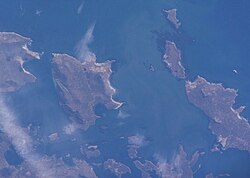Keppel Island
| Keppel Island | |
 Keppel Island from the air | |
|---|---|
| Location | |
| Location: | 51°19’15"S, 59°58’7"W |
| Area: | 14 square miles |
| Highest point: | Mount Keppel, 1,119 feet |
| Data | |
| Population: | 0 |
Keppel Island is one of the Falkland Islands, lying between Saunders Island and Pebble Island, and near Golding Island to the north of West Falkland on Keppel Sound. It has an area of 14 square miles and its highest point, Mount Keppel, is 1,119 feet high. There is a wide, flat valley in the centre of the island with several freshwater lakes. The central valley rises steeply to the south-west, west and north. The north-east is low-lying, with a deeply indented coastline. The main conservation issue is the large population of Norway rats on the island. [1]
History
The island is named after First Lord of the Admiralty, Admiral Augustus Keppel (1725 - 1786).
The island became a sheep farm in 1885, initially doubling as a missionary settlement aimed at the Yaghan people of Tierra del Fuego. More recently, it became a nature reserve. It also has a small settlement on the east coast, but no permanent population.
Missionary station
The mission on Keppel Island was established by the South American Missionary Society in 1855, initially under Captain William Parker Snow, and remained in operation until 1898. It had been proposed by Captain Allen Gardiner, founder of the Society, before his death in 1851, as a less hostile environment from which to gain the confidence of the Yaghan and learn their language. From 1856, several of the Yaghan were induced to move to Keppel Island, and learnt farming techniques and some English. After some setbacks, the mission succeeded in founding a mission at Ushuaia in 1869, under the leadership of Waite Stirling.[2]
The Yahgans did not arrive on the island until a few years after the building of "Cranmer Station" (named for Thomas Cranmer, the Protestant martyr) near Committee Bay. One of the more famous visitors to Cranmer Station (in 1860) was Jemmy Button who had learnt English, and visited England aboard the Beagle in 1830-31.
Today, the mission bailiff's house, the chapel and the stone walls of the Yaghan dwellings still remain intact; some provide foundations for present day buildings. Today the ruins are listed buildings and represent amongst the oldest in the islands.[3]
Outside links
- Keppel Island: the South American Missionary Society settlement in the Falkland Islands
- Keppel Island from Space
- Struggling to save Keppel's history
References
- ↑ http://www.falklandsconservation.com/wildlife/birds/IBAs/iba_keppel.pdf
- ↑ Bridges, E L (1948) The Uttermost Part of the Earth Republished 2008, Overlook Press ISBN 978-1-58567-956-0
- ↑ "Falkland Islands Information Web Portal". Buildings and Structures in the Falkland Islands designated as being of Architectural or Historic Interest. http://www.falklands.info/background/listedb.html. Retrieved 2008-07-08.
- Jeff Rubin, Antarctica (Lonely Planet guide).
- Stonehouse, B (ed.) Encyclopedia of Antarctica and the Southern Oceans (2002, ISBN 0-471-98665-8)